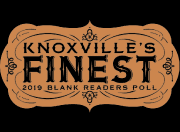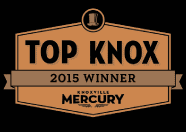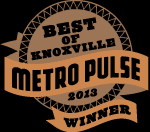
No art exists in isolation, neatly contained within a frame tacked to a gallery wall. It lives within a vast, intricate web of place, time and meaning that floats both ways, art influencing life and life influencing art. The best curators see not just the art but those invisible connecting threads. Like a flashlight catching a spiderweb in the dark, they illuminate the hidden strands, their intersections, and how they spiral in and out in unexpected ways.
As Steven Matijcio approaches the end of his first year as director of the Knoxville Museum of Art, I sat down with him to talk about his experience and what lies ahead. Within moments, one thing became abundantly clear:
This is a man who understands spiderwebs.
Taking Time to Tune In
Matijcio landed in Knoxville with his wife and 4-month-old daughter in the wake of a snowstorm last January. By March, he’d stepped fully into his new role as successor to former director David Butler’s 17-year tenure. Matijcio brought deep experience as both a curator and administrator, having worked in galleries across his native Canada and held curatorial positions in North Carolina and Ohio. Most recently he was director and chief curator at the Blaffer Art Museum at the University of Houston.
But Matijcio wasn’t in a hurry to make sweeping changes. Instead, he spent his first several months in Knoxville simply listening.
“When I get to a new institution, my first three to five months is a listening tour,” Matijcio explains. “I just want to meet the people. I don’t want to come in with a predetermined agenda. People ask, ‘What’s the first show? What’s the first order of business?’ And of course, I have a few things in mind, but I really want to respond, rather than to impose.”
For Matijcio, that meant attending events, exploring the city, and having conversations wherever he could—inside and outside of the museum. He wanted to get a feel for the cultural heartbeat of Knoxville and better understand where the KMA fit into it.
Though new to East Tennessee, Matijcio is no stranger to the Southeast. His decision to come to Knoxville was influenced by the sense of community he had experienced during five years in Winston-Salem, N.C., earlier in his career. There, he witnessed a region in transition, shifting from traditional industries like tobacco and textiles to new creative and technological frontiers. That spirit of transformation and reinvention resonated with him, making Knoxville feel like the right place to build his own next chapter.
As Matijcio listened to museum visitors, staff and community members, he focused on a central question: Why does the KMA matter, and what is its role in Knoxville, the region and beyond?
What he heard wasn’t necessarily about specific artists or exhibitions—it was about accessibility, inclusivity and championing East Tennessee’s creative legacy. People deeply valued Higher Ground, the KMA’s flagship permanent exhibition on regional art, and saw it as fundamental to the museum’s identity.
“Higher Ground took large strides in terms of solidifying what the KMA’s core mandate was—really showcasing the best of East Tennessee, but never being boxed in or being provincial in that way. There was always this impetus and this effort to bridge East Tennessee with larger currents, both within the country and globally. Because oftentimes, you see your immediate surroundings in higher contrast when you have that opportunity to contextualize them on a larger scale.”
That balance—honoring the local while engaging in a larger artistic conversation—was something Matijcio found resonated with many: “They liked the way that the KMA represented that. We championed the local, but we put it into a larger conversation.”

A Vision Takes Shape
As Matijcio listened, one idea kept surfacing—how to build upon Higher Ground without simply reinforcing what had already been done. The exhibition had established the KMA’s role as a champion of East Tennessee’s artistic legacy, but what comes next? How does a museum not just reflect history, but expand its possibilities?
That question led Matijcio to a concept—a sort of philosophical manifesto—he calls the Appalachian Imaginary. Inspired in part by a symposium he attended in Louisville, Ky., titled Global Appalachia, the idea isn’t about defining a singular, fixed vision of the region, but rather embracing its contradictions, myths and evolving identity.
“Appalachia is both overdetermined and chronically misunderstood at the same time,” Matijcio says. “It’s a place steeped in conjecture—people think they know what it is, but what intrigues me is the richness, the diversity and heterogeneity.”
Rather than treating the region’s artistic identity as something static, Matijcio sees it as something alive—unfolding in real time, shaped by both tradition and change. Higher Ground tells the story of what Appalachia has been and what it is today. Now, he wants the KMA to ask: What could it be?
The Appalachian Imaginary, as he envisions it, is a framework for exploring that question. It draws from elements of surrealism, magic realism and futurism—leaning into the myths, legends and Apocrypha that have shaped Appalachian culture while also allowing space for reinvention.
“It’s not about trying to find the one true Appalachia,” he says. “It’s about looking at all the different possibilities.”
In the coming months and years, that idea will start taking form—not as a single exhibition, but as a guiding philosophy shaping the KMA’s programming, collections and collaborations.
Opening in May, Electricity for All, developed by assistant curator Kelsey Conley, examines TVA’s early promise of technological revolution and its double-edged impact on communities. Another exhibition will focus on Little Switzerland, an enclave of modernist architecture in South Knoxville where European influences merged with local vernacular design. No Man’s Land, also curated by Conley, will spotlight a regional artist who placed markers in areas between government jurisdictions, believing they were a means of communicating with the astral world—an exhibition that taps into Appalachia’s deep ties to folklore, mystery and unconventional forms of expression. A series launching in 2026 will spotlight private collections from local residents—not fine art, but the objects they cherish. Whether it’s historical artifacts, regional oddities, or even a collection of velvet paintings, the series will offer a glimpse into what the community values and preserves.
Is the Appalachian Imaginary an abstract concept? Absolutely. But that nebulous quality, Matijcio believes, is its strength.
“The internal conversations we’ve had with our board and our collections committee—they’ve really wrestled with it. Which, I love that. Because I didn’t want something that people kind of shrug their shoulders and say, ‘That sounds nice.’ I want it to be, I don’t want to say contentious, but I want it to be a site for debate,” he says.
Rather than offering a tidy, packaged idea of what Appalachia is, Matijcio wants the museum to foster discussion, questions and even contradictions: “We can bring in artists and scholars and curators and ask them, ‘How do you define Appalachia? What does it look like today? What does it look like tomorrow?’ So it’s something that continues. It’s not going to be a fixed or absolute document. It’s much more about a hypothesis that continues to evolve, shift and morph.”

Extending the Web
For all the high-concept ideas shaping the KMA’s future, Matijcio never loses sight of something fundamental: Not everyone who walks through the door is an art scholar—most people just want to feel … something. A spark of curiosity. A moment of connection. A shift in perspective they didn’t see coming.
It’s easy for an art museum to feel like an ivory tower, and the KMA has worked hard to be anything but. Free admission, free parking and dedicated spaces for hands-on creativity—including the newly renovated Aubrey Jaye’s Art Play, which opens Feb. 9—make it a welcoming place for all. Monthly Soundscapes concerts, Second Sunday family days, and workshops create entry points for visitors of every age, background and comfort level with contemporary art.
One of the biggest takeaways from Matijcio’s listening tour was the hunger for collaboration—not just within the KMA, but across Knoxville’s entire creative network “We want to continue that circulation of art throughout the community,” he says. “Whether it’s UT, Big Ears or other organizations, there’s a real appetite and desire to celebrate and amplify the role of the arts in Knoxville. I’m very intrigued by how we can partner and collaborate in ways that grow that presence.”
Performance is one way the KMA is embracing that spirit. Exhibit openings incorporate live performances—not necessarily tied to the artwork, but in conversation with it. More partnerships with local musicians, dancers and theater groups are in the works, turning the museum into a space where different artistic disciplines intersect and ignite something new.
KMA is also looking beyond its walls, exploring public art expansions, revitalizing its sculpture garden, and even floating the idea of a pop-up café to highlight Knoxville’s colorful food scene. Design, performance, the culinary arts—they’re all part of the same creative ecosystem. “We want the KMA to be a hub for cultural vibrancy in all forms,” Matijcio says.
At its core, Matijcio sees the KMA as a space for discovery, where visitors don’t just come to see something familiar but to be surprised. It’s a container for a living, breathing tangle of art, ideas and people, connecting in ways we have yet to imagine.
“I love walking into a gallery not knowing what it’s going to be, and having it affect you in a way you didn’t expect,” Matijcio says. That sense of risk, he believes, is essential. “I don’t want art to be easy or safe. I want it to challenge people in a good, growth-opportunity kind of way. When something is slightly discombobulating and you’re trying to find new ground, that’s when new thinking can really take root.”
Know Before You Go: KMA (1050 World’s Fair Park Drive) is open Tuesday-Saturday, 10 a.m.-5 p.m., and Sunday 1-5 p.m. Admission is free. Visit knoxart.org for more information.











Recent Comments